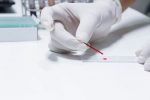RAGE Protein May Be Biomarker for IPF Prognosis, Diagnosis

A protein called RAGE may be a useful biomarker for the diagnosis and prognosis of idiopathic pulmonary fibrosis (IPF), a recent study suggests.
RAGE levels were found to be decreased in the lungs of IPF patients, and in those of mice used to model the human disease. Meanwhile, the levels of fibrotic, or tissue scarring, markers were increased in both patients and animals in the study.
The study, “Reduced receptor for advanced glycation end products is associated with α-SMA expression in patients with idiopathic pulmonary fibrosis and mice,” by a team of researchers from the Republic of Korea, was published in the journal Laboratory Animal Research.
RAGE, short for receptor for advanced glycation endproducts, is a member of the immunoglobulin family of cell surface protein molecules. It is present at low levels in most healthy adult tissues, except in the lungs, where its levels are higher.
However, in IPF, the levels of RAGE — both a form that is bound to the cell surface and one that circulates freely in the blood — are low.
IPF is a disease in which lung tissue becomes thick and scarred for unknown reasons. Researchers in this study thought that RAGE might play a role in that process, which is called fibrosis.
“Our findings suggest that reduced RAGE was associated with increased fibrotic genes in [mouse models] and patients with IPF, the team wrote.
In research, scientists seek biological markers, or biomarkers, that can help in diagnosing disease and aid in determining its prognosis. Developing useful biomarkers usually requires a variety of detailed investigations that include analytical methodology, studies of possible interfering substances, and determinations of normal and disease control values.
Here, when the investigators examined pieces of lung tissue taken from IPF patients, they found that RAGE levels were lower than in lung tissue samples taken from people who did not have the lung-scarring disease.
In contrast, the levels of alpha-smooth muscle actin (SMA) — a marker of activated fibroblasts, or cells found in connective tissue that contribute to fibrosis — were higher in patients with IPF than in those without the disease.
To better understand the relationship between the levels of RAGE and the process of fibrosis, the researchers turned to mice in which the disease was triggered by exposing animals to a chemical called bleomycin.
Within two weeks of bleomycin exposure, the mice showed an increase in the numbers of macrophages and neutrophils — two types of immune cells involved in inflammation — in their lungs.
At the same time, the levels of fibrotic markers — including alpha-SMA — were increased. RAGE levels were decreased, particularly in areas in which lung epithelial cells, which line the airways, appeared to be lost.
“Our results suggest that continuous loss of alveolar epithelial cells and increased fibroblasts … leads to down-regulation of RAGE during IPF progression,” the researchers wrote.
“Therefore, RAGE could be applied [as] a biomarker for prognosis and diagnosis in the pathogenesis [mechanisms] of IPF,” the team concluded.









